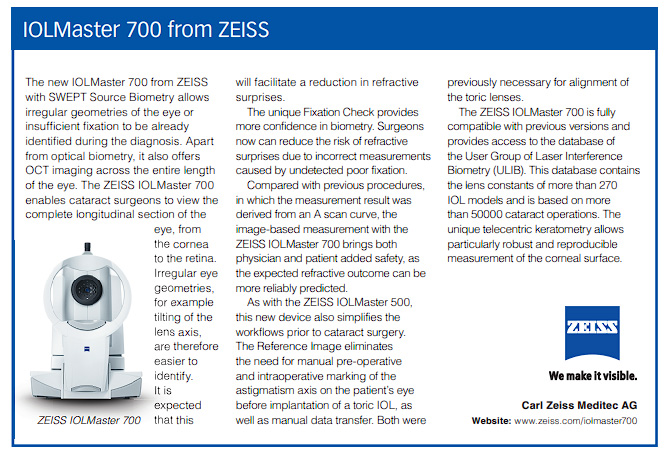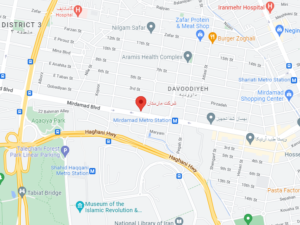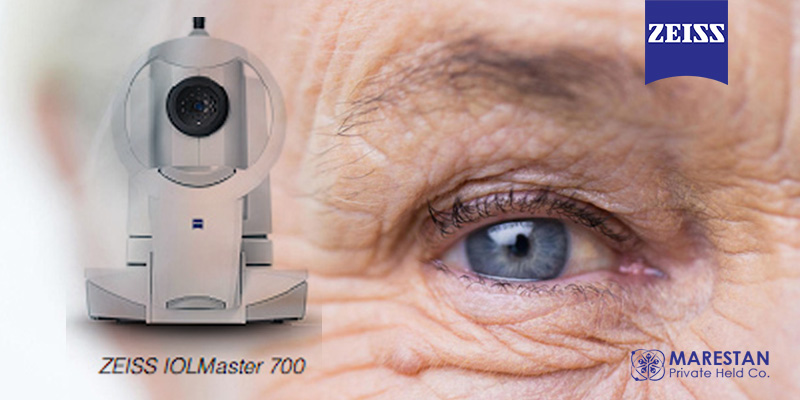The new IOLMaster 700 from ZEISS — First
Results concerning the Cataract Penetration Rate
By Dr Michel Puech, Explore Vision Paris, France For more than 15 years, the IOLMaster has become the benchmark for optical biometry instruments1 with a large number of devices in use and excellent compatibility with the values of the IOL constants given by the ULIB site. The arrival of a new biometric instrument, the IOLMaster 700, has generated great interest. This is particularly the case because it is the first time that SWEPT Source OCT technology has been brought into the field of biometry. This technology provides clear advantages over the previous systems, including the possibility of detecting unusual eye geometries and poor fixation patterns. This allows for a more accurate performance of IOL power calculations and, consequently, a significant improvement in the refractive outcomes. Furthermore, the SWEPT Source OCT technology has the additional advantage of its extremely rapid data acquisition,2 including the ability to measure the axial length along 6 different axes. We have recently performed a study comparing the new IOLMaster 700 with the previous IOLMaster 500. We sought to discover in how many cases limited transparency of ocular media made biometric measurements impossible. Methods and materials Patients who were referred to the Centre Explore Vision in Paris for IOL power calculation were consecutively included in this prospective study. In all cases, axial length measurements were performed with the IOLMaster 500, followed by a measurement with the IOLMaster 700. A total of 427 eyes were examined, of which 288 eyes were eligible for the current study. The exclusion criteria included eyes with active ocular pathologies, such as uveitis or retinal degenerations, as well as eyes that had undergone previous ocular surgery. We counted the cases where no measurement was possible, which was most frequently due to the loss of transparency in the media, and then compared this number between the devices. Results It was not possible to obtain a biometric measurement in a total of 31 eyes (10.76%) with the IOLMaster 500. In all cases, this was due to the reduced transparency in the ocular media of these eyes. In contrast, with the IOLMaster 700, it was only in 16 eyes (5.55%) that no measurement was possible. This was also due to the insufficient transparency of the ocular media. In oursample, the IOLMaster 700 halved the number of cases in which an axial length measurement could not be obtained.
Discussion
The fact that the IOLMaster 700 performs 6 radial scans helps to optimize the axial length measurement when compiling the results. This seems to be the main reason to explain our results. Likewise, the fact that SWEPT Source OCT technology is used, has the advantage that the entire eyeball is scanned, and the different structures to be found in the entire visual axis are recognized. This facilitates the proper axial length measurement, even in the presence of some dense cataracts. Furthermore, unusual eye geometries such as tilt or decentration of the crystalline lens can be detected and taken into consideration in the choice of IOL model. The fixation check of the IOLMaster 700 is another advantage of this new biometer. It enables the examiner to check whether the image is being obtained in the right position and to reduce the risk of refractive surprises due to incorrect measurements caused by undetected poor fixation. Finally, the possibility of visually verifying of which structures of the eye have indeed been measured is of great help.
Conclusion
The IOLMaster 700 is more effective in obtaining biometric measurements in eyes with less transparent ocular media. The check for decentration or tilt of the crystalline lens, the fixation pattern, and the visualization of the measured structures all help to eliminate potential sources of error and, therefore, to optimize cataract surgery outcomes.
References
1. J. Santodomingo-Rubido et al., Br. J. Ophthalmol.,
2002;86:458–462.2. W. Drexler et al., J. Biomed. Opt., 2014;19:071412.







